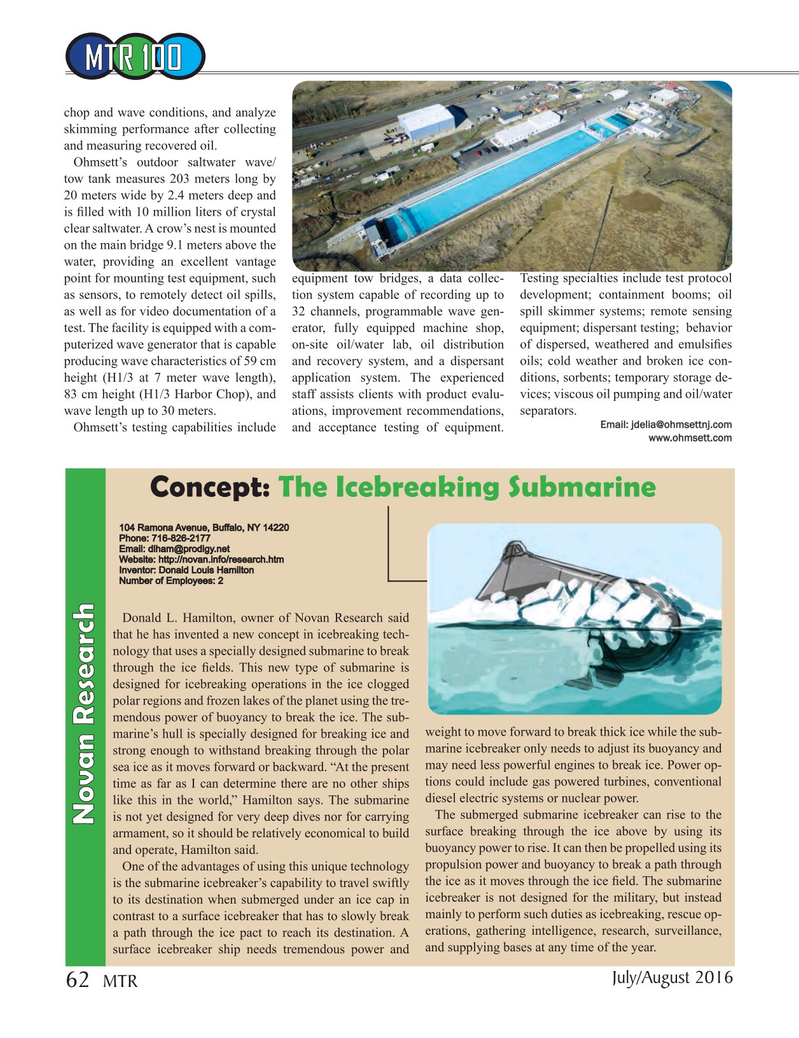
Page 62: of Marine Technology Magazine (July 2016)
MTR 100: The 11th Annual Listing of 100 Leading Subsea Companies
Read this page in Pdf, Flash or Html5 edition of July 2016 Marine Technology Magazine
MTR 100 chop and wave conditions, and analyze skimming performance after collecting and measuring recovered oil.
Ohmsett’s outdoor saltwater wave/ tow tank measures 203 meters long by 20 meters wide by 2.4 meters deep and is ? lled with 10 million liters of crystal clear saltwater. A crow’s nest is mounted on the main bridge 9.1 meters above the water, providing an excellent vantage point for mounting test equipment, such equipment tow bridges, a data collec- Testing specialties include test protocol as sensors, to remotely detect oil spills, tion system capable of recording up to development; containment booms; oil as well as for video documentation of a 32 channels, programmable wave gen- spill skimmer systems; remote sensing test. The facility is equipped with a com- erator, fully equipped machine shop, equipment; dispersant testing; behavior puterized wave generator that is capable on-site oil/water lab, oil distribution of dispersed, weathered and emulsi? es producing wave characteristics of 59 cm and recovery system, and a dispersant oils; cold weather and broken ice con- height (H1/3 at 7 meter wave length), application system. The experienced ditions, sorbents; temporary storage de- 83 cm height (H1/3 Harbor Chop), and staff assists clients with product evalu- vices; viscous oil pumping and oil/water wave length up to 30 meters. ations, improvement recommendations, separators.
Email: [email protected]
Ohmsett’s testing capabilities include and acceptance testing of equipment. www.ohmsett.com
Concept: The Icebreaking Submarine 104 Ramona Avenue, Buffalo, NY 14220
Phone: 716-826-2177
Email: [email protected]
Website: http://novan.info/research.htm
Inventor: Donald Louis Hamilton
Number of Employees: 2
Donald L. Hamilton, owner of Novan Research said that he has invented a new concept in icebreaking tech- nology that uses a specially designed submarine to break through the ice ? elds. This new type of submarine is designed for icebreaking operations in the ice clogged polar regions and frozen lakes of the planet using the tre- mendous power of buoyancy to break the ice. The sub- marine’s hull is specially designed for breaking ice and weight to move forward to break thick ice while the sub- strong enough to withstand breaking through the polar marine icebreaker only needs to adjust its buoyancy and sea ice as it moves forward or backward. “At the present may need less powerful engines to break ice. Power op- time as far as I can determine there are no other ships tions could include gas powered turbines, conventional like this in the world,” Hamilton says. The submarine diesel electric systems or nuclear power.
The submerged submarine icebreaker can rise to the is not yet designed for very deep dives nor for carrying
Novan Research armament, so it should be relatively economical to build surface breaking through the ice above by using its buoyancy power to rise. It can then be propelled using its and operate, Hamilton said.
One of the advantages of using this unique technology propulsion power and buoyancy to break a path through is the submarine icebreaker’s capability to travel swiftly the ice as it moves through the ice ? eld. The submarine to its destination when submerged under an ice cap in icebreaker is not designed for the military, but instead contrast to a surface icebreaker that has to slowly break mainly to perform such duties as icebreaking, rescue op- a path through the ice pact to reach its destination. A erations, gathering intelligence, research, surveillance, surface icebreaker ship needs tremendous power and and supplying bases at any time of the year.
July/August 2016 62
MTR
MTR #6 (50-65).indd 62 7/27/2016 2:38:23 PM

 61
61

 63
63
